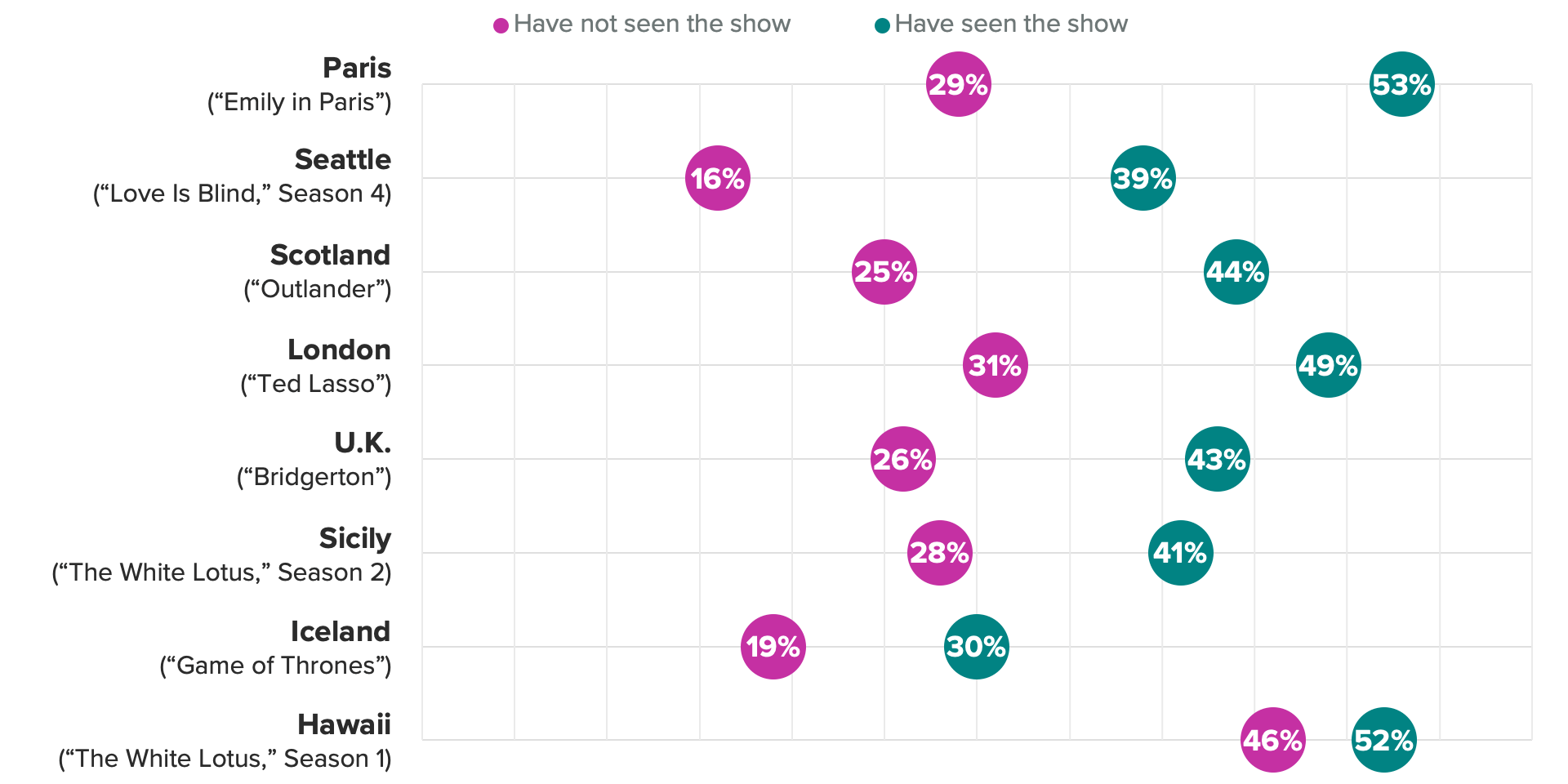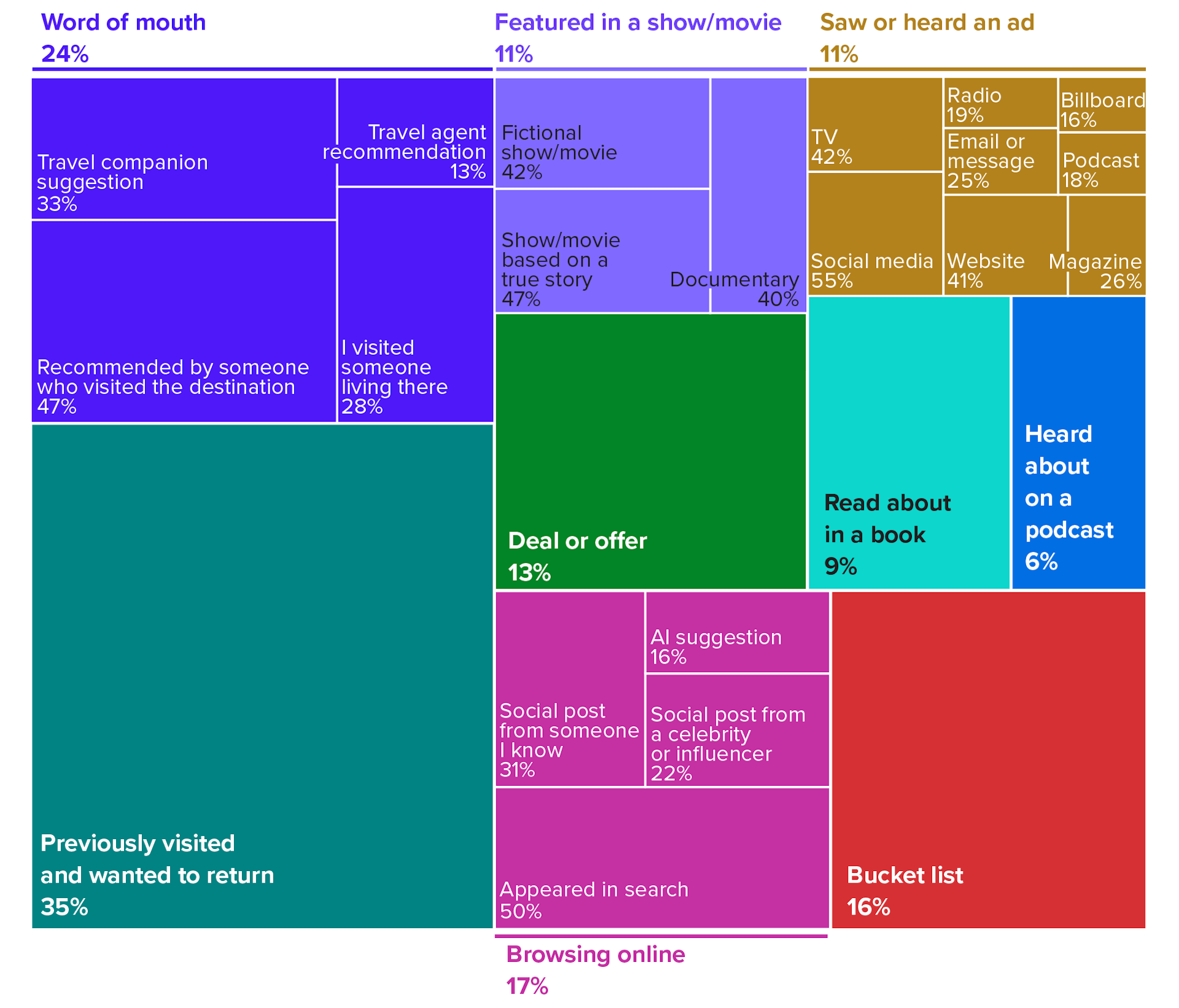‘Set-Jetting’ and Beyond: Where Travelers Are Finding Vacation Inspiration

Key Takeaways
Among those who took a leisure trip in the last year, 11% said they learned about the destination from a TV show or movie — the same as the share who said they heard about it from an advertisement.
Those who have seen TV shows or movies that prominently feature a destination are more likely to express interest in visiting the destination than those who haven’t.
Sources of inspiration and steps in the path to purchase vary by generation and lifestyle, so companies must consider different approaches for different travelers.
Sign up to get our analysis and data on the travel & hospitality industry delivered straight to your inbox.
The path to purchase in travel is a winding one. Those planning a leisure trip have many different considerations: when to travel, where to stay, how to get there and how to spend their time away. But for most, the first step is simply deciding where to go. Destination inspiration can strike anywhere, at any time. But a recent Morning Consult survey reveals that what people stream plays a key role in inspiring trips.
Streaming content is as likely to inspire a trip as advertising
“Set-jetting” — planning a vacation to a destination from a film or television show — is not a completely new concept. “The Lord of the Rings” has inspired many a trip to New Zealand, devotees of “Harry Potter” have flocked to Platform 9¾ at London’s King’s Cross Station and Hawaii has drawn tourists who hope to marvel at the lush (albeit dinosaur-free) landscape of Kauai. But the recent increase in high-production streaming originals that feature picturesque settings has accelerated and broadened the trend.
When asked where they heard about the destination of their most recent leisure trip, 11% of U.S. adults who took such a trip in the last year said that they had seen it in a television show or movie — equal to the share who said they’d seen an advertisement for the location. And when asked more specifically about their interest in visiting destinations that featured prominently in popular TV shows, those who had seen the shows were far more likely to be interested in visiting than those who hadn’t.
TV Watchers Are More Likely to Want to Visit Destinations Featured in Their Favorite Shows

Destinations that experienced the biggest boosts in high interest among those who had seen the associated content varied widely in programming tone, subject matter and streaming platform. Those who watched Season 4 of Netflix’s popular reality show “Love Is Blind” were 23 percentage points more likely to say they were “very interested” in visiting Seattle than those who hadn’t seen the show, and “Outlander,” a historical drama distributed by Starz, saw a similar trend. Viewers of the series were 19 points more likely to be very interested in visiting Scotland than nonviewers. And those who watched Ted Lasso were 18 points more likely to express strong interest in going to the British capital than those who hadn’t.
Specific demographics at scale: Surveying thousands of consumers around the world every day powers our ability to examine and analyze perceptions and habits of more specific demographics at scale, like those featured here.
Why it matters: Leaders need a better understanding of their audiences when making key decisions. Our comprehensive approach to understanding audience profiles complements the “who” of demographics and the “what” of behavioral data with critical insights and analysis on the “why.”
While the higher interest levels aren’t always proportional to the size of the show’s viewership, or to baseline interest in the destination, it should be noted that viewership of any piece of content was associated with increased interest in all destinations. This is likely due to some overlap in viewership, but it also suggests demographic and attitudinal influences. Consumers with streaming subscriptions are more interested in activities like concerts, sporting events and theme parks than others, so it stands to reason that they may also be more likely to travel more frequently and to have higher awareness of the destinations featured in their favorite shows. Additionally, individuals in higher-income households are more likely to subscribe to more streaming services. This group also travels more frequently and would be exposed to more destinations than their lower-income counterparts. Nonetheless, the relationship between viewership and interest in traveling suggests that set-jetting is here to stay.
Travelers are inspired by a wide variety of sources
While set-jetting is a popular and growing trend, streaming content is not the most common source of inspiration for travelers. When asked about their most recent leisure trip, travelers were most likely to say they heard about the destination through a personal experience or recommendation. More than one-third said that they had been to the destination before and wanted to return, while 24% said someone they know had recommended it to them.
Past Trips Are Most Likely to Drive Future Bookings

Outside of personal experience or recommendations, the most common source of inspiration was the internet: 17% of travelers said they heard about their destination while browsing online. And while half of those who said they heard about their vacation destination online said they found it while actively searching for options, just as many saw it passively on social media. Nearly a third of travelers who heard about their vacation destination online said someone they know had posted about it on social media, and 22% said they discovered it in a post from an influencer or celebrity, a nod to the enduring relevance of social content in exposing travelers to new destinations.
Millennials find travel inspiration everywhere
Millennials, who tend to travel for leisure more than their generational counterparts, cited the widest variety of inspiration sources. While similar shares of millennials say they were either returning to a place they wanted to revisit or traveling to a destination someone had recommended to them, they were far more likely than other generations to find inspiration in TV or movies: 21% have taken a set-jetting vacation, compared with 10% of Gen Z adults, 7% of Gen Xers and 5% of baby boomers. They are also more likely than other generations to say they heard about their destination from a podcast or a book, underscoring the value of content in introducing destinations to this travel-happy generation.
It’s notable that the first step in the path to purchase is more variable for younger travelers. Gen Zers and millennials are less likely than older generations to start by researching destinations. Instead, Gen Zers tend to do front-end research on accommodations, meaning hospitality brands can play an important role in travel inspiration. Millennials, on the other hand, tend to research activities earlier in the process, reinforcing the idea that experience is crucial for this generation.
Generations Differ in Their Destination Priorities
When deciding on a destination, generations also differ in what matters most. Older travelers — Gen Xers and baby boomers — are more likely than their younger counterparts to cite cost, climate and ease of access to the destination as key priorities. While these considerations are also important to younger generations, Gen Zers are more likely to prioritize personal safety, while millennials favor destinations that feature culinary experiences or outdoor adventures.
Ultimately, the path to purchase in travel is far from linear, as well as highly variable based on demographic. Travel companies must personalize as much as they can based on knowledge of the individual traveler to reach them in the right frame of mind. And, of course, sweeping shots of a beautiful locale in Netflix’s latest hit don’t hurt either.
Clarification: This analysis has been updated to more accurately characterize the shares of respondents who heard about their vacation destination through an online search versus on social media.
Lindsey Roeschke is an analyst whose work focuses on behavior and expectations of consumers in the travel & hospitality and food & beverage categories, particularly through a generational and cultural lens. Prior to joining Morning Consult, she served as a director of consumer and culture analysis at Gartner. In addition to her research and advisory background, Lindsey has more than a decade of experience in the advertising world. She has lived and worked in seven cities across four continents.